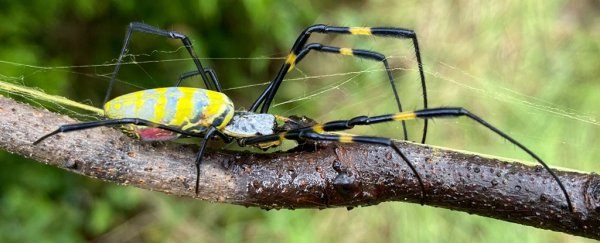Say hello to the Jorō spider (Trichonephila clavata), an arachnid you're likely to be seeing a lot more of in the future if you live on the East Coast of the US.
New research suggests the distinctive black-and-yellow creature – currently flourishing in the state of Georgia – is unlikely to face any barriers in terms of being able to spread. That's based on a detailed comparison with another Georgia resident and fellow invasive species, the golden silk spider (Trichonephila clavipes).
The comparison shows the Jorō has a faster metabolism, a higher heart rate, and more resilience against the cold. Plus, it has already colonized most of its native Japan – a country that has a similar climate to the continental US and sits on approximately the same latitude.
"Just by looking at that, it looks like the Jorōs could probably survive throughout most of the Eastern Seaboard here, which is pretty sobering," says ecologist Andy Davis from the University of Georgia.
Researchers compared the Jorō and golden silk spiders in a few different ways to gauge the former's ability to thrive in the US.
First, researchers looked at how much oxygen the spiders consumed, finding that the Jorō's metabolism is about double that of a golden silk spider. "High metabolism is known to allow, for the growth and activity of spiders during colder temperatures," the researchers explain in their published paper.
Second, the spiders' respective heart rates were analyzed under chilly conditions Researchers placed the spiders on ice for 10 minutes and then measured the spiders' body temperature. The Jorō spiders' heart rates on the ice were about 77 percent higher than their cousins', again indicating an ability to stand up to the cold.
Finally, to determine the spiders' cold resistances, spiders were placed in a freezer that started at around 10 degrees Celsius (50 degrees Fahrenheit) and was gradually chilled to just below freezing over the course of 15 minutes. None of the Jorōs died during this test, though some did experience cold-related injuries. Meanwhile, four of the golden silk spiders died, and another six were also injured by the exposure.
Researchers also used sightings logged in the iNaturalist citizen science project to track how the Jorō spider spread across the Southeastern US from 2015 to 2021 – and it's going at quite a pace.
In the space of around eight years, the team estimates that the area where these arachnids live now includes North Carolina, South Carolina, Tennessee, and Oklahoma, in addition to Georgia. The golden silk spider, by comparison, has been in the southeastern US for 160 years after getting there from Central and South America.
From the trio of tests and the geographical spread, the researchers concluded "that the Jorō spider has a physiology that is more suited to a cooler environment than its congener, which we know is limited to the southeastern USA. Our own freeze-trials alone indicate the golden silk spider cannot withstand even brief freezes, while the Jorō can."
That spread is also helped by the way that Jorōs can use their silks to carry themselves across the wind to new places, a technique called ballooning. The researchers found that hatchlings typically ride to somewhere new after emerging in the spring.
According to the researchers, the first Jorō spiders in the US were likely to have stowed away on shipping containers.
"People should try to learn to live with them," says Davis. "If they're literally in your way, I can see taking a web down and moving them to the side, but they're just going to be back next year."
Fortunately, there's no reason to panic. These spiders – which measure 17-25 mm in size for adult females, and 7-10 mm for adult males – don't pose much of a threat to people or pets. They won't bite unless cornered, and their fangs usually aren't big enough to break through human skin.
And the researchers are keen to point out that Jorōs didn't choose their new life in the United States – they were removed from the natural habitat due to human activities, so we should treat them as guests.
"There's really no reason to go around actively squishing them," says the study's co-author Benjamin Frick from the University of Georgia. "Humans are at the root of their invasion. Don't blame the Jorō spider."
The research has been published in Physiological Entomology.
